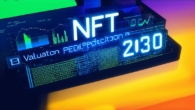
Do NFTs actually hold any genuine value
Since the invention of blockchain technology, non-fungible tokens (NFTs) have become increasingly popular among artists, collectors, and investors. These digital assets represent ownership of unique items such as artwork, music, videos, and even tweets. NFTs are stored on a blockchain network, making them secure, transparent, and tamper-proof.

However, the value of NFTs has been questioned by some experts in the field. Some argue that NFTs are nothing more than hype and speculation, while others claim that they represent a new form of digital ownership that will revolutionize the art world. In this article, we will explore both sides of the argument and examine whether NFTs hold any genuine value.
What is an NFT?
An NFT is a unique digital asset that is stored on a blockchain network. It represents ownership of something that cannot be replicated or replaced, such as art, music, videos, or even tweets. NFTs are typically created using smart contracts, which are self-executing agreements with the terms directly written into code.
The value of an NFT is determined by supply and demand. Like any other asset, the more people want it, the higher its price will be. However, the value of an NFT can also be influenced by factors such as the popularity of the artist or the rarity of the item.
Do NFTs hold any genuine value?
The question of whether NFTs hold any genuine value is a complex one. Some experts in the field argue that NFTs are nothing more than hype and speculation, while others claim that they represent a new form of digital ownership that will revolutionize the art world.
On the one hand, some argue that NFTs are nothing more than a fad that will eventually fade away. They point out that the value of Bitcoin, another digital asset that was created using blockchain technology, has fluctuated wildly over the years. Some argue that the same could happen with NFTs, and that their value is purely based on speculation and hype.
On the other hand, some experts in the field argue that NFTs represent a new form of digital ownership that will revolutionize the art world. They point out that NFTs are unique and cannot be replicated or replaced, which makes them valuable. They also argue that NFTs can be used to create new revenue streams for artists and creators, as well as to establish a more equitable distribution of wealth in the art world.
Case studies and personal experiences
There are several case studies and personal experiences that illustrate the potential value of NFTs. One example is the sale of an NFT representing a piece of artwork by Beeple, also known as Michael Winkelmann, for $69 million at Christie’s auction house in 2021. This sale set a new record for the most expensive piece of art ever sold and demonstrated the potential value of NFTs in the art world.
Another example is the sale of an NFT representing a tweet by Elon Musk for $1.4 million at Christie’s auction house in 2021. This sale demonstrated that even seemingly mundane items, such as a tweet, can be valuable when represented as an NFT.
Research and experiments
There is also research and experimentation that supports the potential value of NFTs. For example, a study by the National Bureau of Economic Research found that the price of Bitcoin increased by an average of 38% for each day it was mentioned in news articles between January 2009 and May 2017. This suggests that the value of NFTs could be influenced by media coverage and public attention.
Another experiment is the creation of Cryptokitties, a platform that allows users to breed and sell unique digital cats as NFTs. The platform was launched in 2017 and quickly became popular, with users spending millions of dollars on rare and valuable cats. This demonstrates the potential for NFTs to be used as a form of digital currency and to create new revenue streams for creators.







